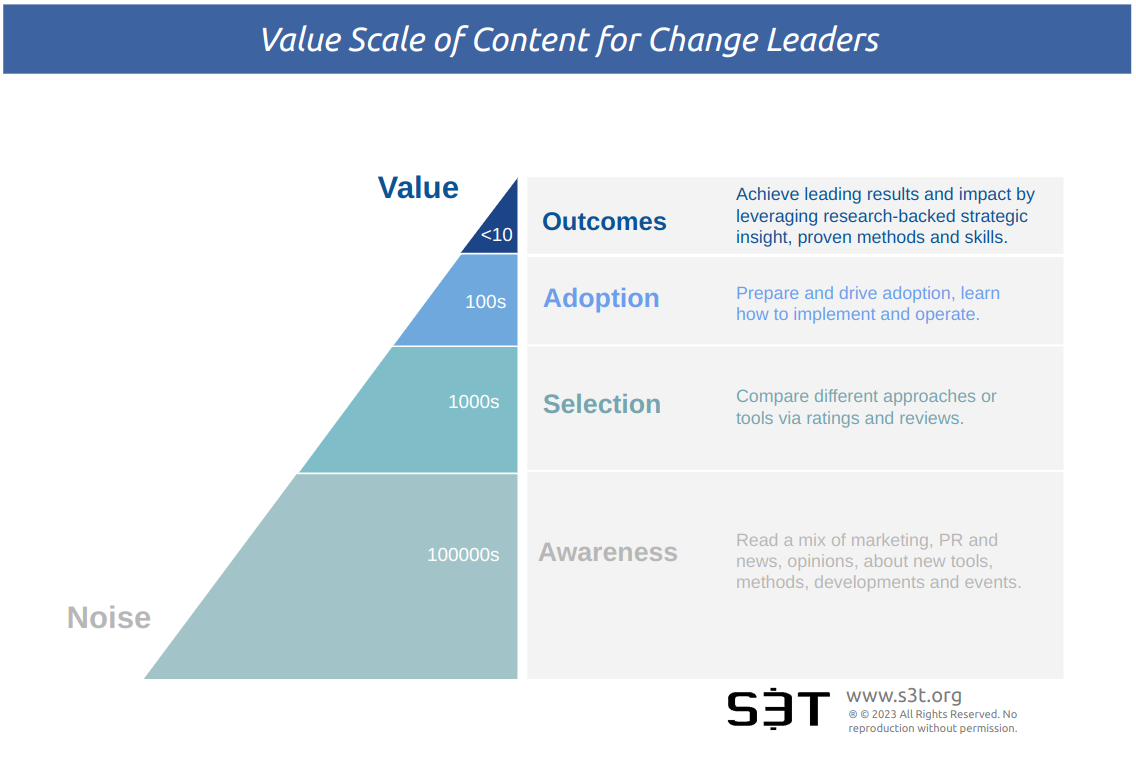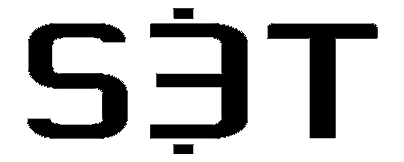S3T August 4 - Content value scale, RT-2, China & the global south, Health inequities, VC spring, Lox

🔊 Listen to this newsletter on the S3T Podcast
In this edition:
- Change Leadership Skills: Use this content filter to accelerate your learning and impact.
- Macroeconomics: China is investing in the global south, health inequity is costing trillions,
- Emerging Tech: Dawn of conversational interfaces for robots, Crypto finding a home in the Netherlands, Tech startups are back
- Just for Fun: An inspiring win-win for South African people and nature; The long history of Lox

Change Leadership: Staying Informed in an age of Information Overload
Getting more informed in less time sounds like an impossible dream, but it's not.
Change Leaders want to stay informed about key developments in economics and emerging tech because both are deeply connected to the problem spaces where we innovate solutions and drive needed change. Unpleasant fact: Today's complex environment requires a cross-disciplinary approach to learning and skill building.
Overlords of Overload
Unfortunately, tech and economics are large spaces, and today’s technology, finance, and business media produce more articles, newsletters, and social media threads than anyone could possibly read.
When you do try to catch up, the information overload leaves you feeling less informed than when you started. With an even longer list of things to catch up on.
This will only get worse as media companies embrace GenAI and flood the Internet with automated low trust content.
What is the best lens to filter out the noise and find the important signals you need to focus on? How do you connect with the insights and learning most helpful for what you’re working on right now?
Fortunately, there is a lens you can start using right now that will let you do exactly this. I use this lens to filter out the noise and focus on what deserves attention and want to share it with you.

How it works
This lens shows you the 4 categories of news sources that exist so you know which ones to pay less attention to and hone in on the ones that can offer you the most value in the least amount of time.
It works because it categorizes in reference to what you are trying to accomplish and what kind of impact you want to have.
Let’s look at the 4 categories of information sources so you can learn to find and focus on what helps you the most and reduce time spent reading or scrolling through low-value content.
4 Categories of Information Sources for Change Leaders
Category 1: Awareness Content makes you aware of general news, events and views in industry and tech.
- Overwhelming numbers of items every day - 10s of thousands.
- Hard to differentiate actionable info from PR, marketing, opinions and hype.
- Overwhelmingly ad-supported, often in a highly distracting reading experience.
- Good for: Not much, but it does signal hype cycles and bubbles (When the market is highly excited, you should probably be the opposite).
The majority of newsletters, industry magazines, and social media channels fall into this category. They promise to make you aware of emerging technology or industry trends, usually via an ad-supported platform.
This is the easiest source to encounter but generally a low-quality one, and not a good use of time.
Category 2: Selection content helps you select technologies, tools, or investments
- Hundreds of sources and items - too many to keep up with.
- Ratings, Reviews, sometimes published side by side with marketing or PR info
- Usually ad-supported
- Good for: knowing the dominant purchasing and investing themes.
This smaller subset of information sources aspires to provide something beyond mere awareness and help readers understand which technologies and trends may be worth paying attention and investing in. This category caters primarily to two kinds of readers:
- Individual or Corporate decision-makers who are contemplating technology tools or systems.
- Investors who seek early involvement in promising opportunities. This subset includes newsletters that target profit-seeking investors by providing strategies for early exposure to the adoption of emerging technologies.
Category 3: Adoption content helps customers adopt and implement new technologies.
- Fewer sources and items, with varying quality
- Longer reads discussing adoption and implementation approaches, risks and maturity paths.
- Often published as limited free content by consulting or tech services companies to demonstrate expertise to potential clients.
- Good for: Case studies of implementations (sometimes) or more technical explanations of implementation options.
This is a smaller subset focused on helping customers adopt and implement new technologies. Usually, these information sources are written by the staff of larger consulting companies for the purposes of attracting large corporations who need system implementation services.
Category 4: Outcomes-focused content helps change leaders gain insights and build skills to drive successful results.
- Very few sources offer this
- Curates the best of the first 3 categories, but adds research-backed strategic insights and proven methods for success.
- Written from first-hand experience and expertise
- Good for: purpose-driven leaders and teams who need more focused insights and skill building because they have a target outcome they are trying to achieve.
This is the sweet spot for mission-driven innovators - change leaders who need to work in complex regulated environments to bring measurable real-world benefits while also managing risks and preventing bias and harm. There is not a lot of this kind of content out there, but when you see it, it stands out from everything else.
Apply this to your strategy for staying ahead of the curve
Next time you're listening to a podcast, or reading online, consider which of these 4 categories that content falls into, so you can make the most of your limited time for learning and planning.
Beyond that, set aside time each week when you will spend time intentionally to update your understanding of economic and emerging tech developments and sharpen your change leadership skills.
Make yourself a list of the few information sources you will consult. You'll want to curate this short list so that it gives you the maximum value in the shortest amount of time.
When you read and spent time online, notice how different reading experiences and information sources make you feel. If you leave feeling overwhelmed, behind the curve, or inadequate, then you are probably spending time with a publication or platform where one or more of the following are true:
- The content is not well-curated,
- Advertising is the key driver (Reading experience and comprehension is secondary)
- The platform caters to participants who like to display what they know rather than help others learn.
To recap: you've just gained a valuable lens for viewing and filtering the massive amount of content being generated on a daily basis. By putting this lens to work you can maximize your learning and effectiveness while making the best use of your time and focus. Good luck!

Macroeconomics
China and the global south
China is building trade relationships across the global south - selling tech, infrastructure, and a vision that these countries (which in some ways resemble what China looked like a generation ago) can become modern powerhouses too.
Cost of inequities in healthcare
A new healthcare study finds health inequities cost the state of Massachusetts alone 23.5 billion per year. These state-level findings align with broader research noted in the Aug 21, 2022 edition of S3T, summarized in this Economic Letter from the Federal Reserve Bank of San Francisco (Oct 2021). Bottom line: inequality is costing the U.S. Trillions.
For example, if just four key racial gaps for Blacks — wages, education, housing, and investment — were closed 20 years ago, $16 trillion could have been added to the U.S. economy. (Closing Racial Inequity Gaps Dana Peterson, Catherine Mann Sept 2020).
The economic impact of this issue has prompted the National Academies to call for a federal agency responsible for implementing a health equity policy audit and scorecard.
If you want to engage your analytics team to take action in your community on this issue, here is an excellent guide to help you get started: The Massachusetts Office of Health Equity has created a Racial Equity Data Road Map which is so much more than a roadmap. It’s a tool kit with a wealth of resources:
- Reframing exercises to raise awareness,
- Detailed pointers for data and analytics practitioners selecting data sources,
- Methods for measuring health inequities,
- Guidance for creating initiatives that use data to improve health equity.
Highly recommended for change leaders who intend to formulate an approach for taking action.
Emerging Tech
Google's RT-2 Brings Conversational Interface to Robots
Google has just announced RT-2 a breakthrough capability that allows a person to give a robot verbal commands for performing tasks with real-world objects. This represents a step beyond the digital manipulation of ChatGPT - where text strings or data elements are manipulated in response to human language prompts:
- Recognizing and storing information about physical objects in the robot's vision
- Recognizing and responding to human commands that refer to physical objects in the robot's vision
- Moving robot arms and grippers to manipulate physical objects
This shorter post summarizes (with links to deeper material) the chain-of-thought prompting and vision models that enable robots to recognize objects in context, distinguish them from other objects and then manipulate them in response to commands - all without requiring explicit training.
Tech & VC Spring?
There are signs that the VC and Tech winter may be thawing and that the worst is over.
- Polychain just raised $200M for its next round venture fund.
- This interesting perspective from Israel suggests that Europe and US VCs are moving forward faster than Israel (Israel has long been a leader in tech startups).
Crypto.Com
Crypto.com has received approval to conduct business in the Netherlands. The approval from the Dutch central bank confirms the firms compliance with anti-money laundering and other laws and marks the 37th crypto firm to gain approval in the Netherlands.
For Paying Members
🏫 S3T Resource Library
Curated collections of insights, time-saving explainers and accelerators that frame key trends and issues with important context and perspectives. Some include worksheets or additional resources.
🛠 40 Best Online Tools & Resources
Top trusted online tools that save you time and $$$, as well as best online sources for emerging tech & research, economic insights, shifts, trends, history, culture and nature.
🌍 Global Economic Dashboard
500+ US & Intl real-time economic indicators organized by nation and release dates. Tap or click any indicator for detailed charts.
🪙 Crypto Market Caps
Top 100 Crypto Market Prices and Indicators. Colors indicate 24hr price movement, size of boxes indicate Market Cap.
Not a paying member? Sign up for your 14 day free trial!

Nature Notes: Inclusivity and Increased Access to Scientific Knowledge
Roberts, a historic publisher specializing in documenting and sharing knowledge of the ~900 bird species of South Africa is now partnering with Cornell University and Birds of the World.
The Birds of the World online library - the definitive source for global information and data on bird species will now feature the Roberts content starting with version 8 - referred to as "Robert's 8."
The partnership creates a win for ornithology and inclusivity:
- Available in 90+ languages and dialects.
- Available free for those living in South Africa (normally paid subscription).
- Standardizes and enriches the available data and information, and media about South African bird species.
I call this out because it's a notable example of change leadership values at work: Instead of settling for a narrow improvement to scientific curation, the teams acted with broader awareness and enabled increased benefits and access for regional communities. Learn more at the link below.

Sensible Ideas: Lox
The next time you're enjoying lox and bagels, remember this family tree of Indo-European languages which depicts the ancestry of the 440 languages spoken by half of the world's population today. As explained by Sevindj Nurkiyazova, the 8,000-year-old word Lox is living proof of multiple relationships in that family tree, due to its startlingly unchanged meaning and pronunciation over eight millenia.
:extract_focal()/http%3A%2F%2Fstatic.nautil.us%2F16021_16b2399ccd1419de9e098d7abf025eb6.jpg)
According to this history, bagels and lox were invented in the 1930's as a kosher alternative to eggs benedict which had become a sensation at the time.
If you want to chase down the very best in lox and bagels here are 2 guides:
- Food & Wine's guide to the best bagels in America
- Taste Atlas's guide to the best bagels and lox in the world.
Adventure beckons.
Final Note and Thank You!
Hi, I’m Ralph Perrine, founder of S3T Newsletter. Thanks for reading this week’s edition!
I created S3T to empower change leaders with the knowledge and insights they need to navigate the ever-evolving landscapes of economics and emerging tech. Together, let's embrace challenges, seize opportunities, and shape a brighter future through effective leadership and strategic innovation.
If you have any questions or suggestions, I’d love to hear your thoughts! Direct message me @ralphperrine on LinkedIn or Twitter anytime. Thank you!
Cheers,
Ralph
Opinions expressed are those of the individuals and do not reflect the official positions of companies or organizations those individuals may be affiliated with. Not financial advice. Authors or guests may hold assets discussed.



Member discussion